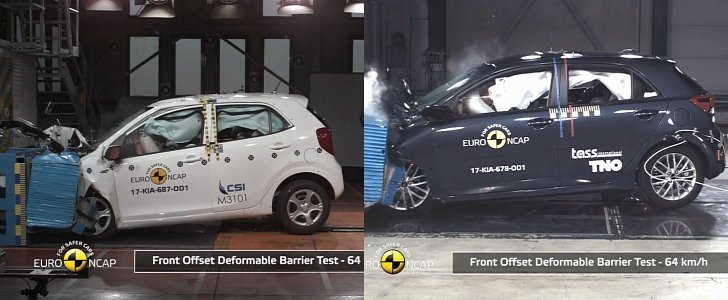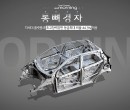In 2017, crash tests are more difficult than ever. In response the ongoing trend, automakers improve the way they build cars and step up their safety features to levels that weren’t even imaginable 10 years ago. Kia, however, is lagging behind as far as the crashworthiness of the new Picanto and Rio are concerned.
Both models are all-new from the ground up, yet Euro NCAP couldn’t give the city car and subcompact hatchback more than three stars. The Picanto, for example, is rated 79 percent for adult occupant protection. The main reason comes down to “marginal” driver’s chest protection in the frontal offset crash.
The full-width rigid barrier test, meanwhile, reveals that high deceleration is the cause of “weak” protection to the rear passenger’s head and “marginal” protection to the chest. On the upside, even a small hatchback like the Picanto is available with an autonomous braking system that does its job perfectly fine, unless it's a pedestrian.
Then there’s the problem of child occupant protection, which the Euro NCAP rated at an abysmal 64 percent. The biggest offender is the neck tension indicated by the 10-year-old dummy, whereas the 6-year-old dummy makes do with “marginal” chest protection. What’s more, the rear center seat cannot accommodate universal child restraints that make use of the center safety belt.
Moving on to the Rio, the Euro NCAP highlights “there was insufficient pressure in the driver's airbag to prevent the head from 'bottoming out' the airbag.” The drawback comes in the form of “marginal” whiplash protection for the rear occupants in the event of a rear-end collision. Similar to the Rio, the Picanto prides itself on an optional autonomous emergency braking system.
When it comes to child occupant protection, only the 6-year-old crash test dummy measured worrying information in the frontal offset test, which takes place at 64 kilometers per hour. In this scenario, the child’s chest is prone to injury, which is why the organization couldn’t give the Picanto anything better than “marginal.”
The full-width rigid barrier test, meanwhile, reveals that high deceleration is the cause of “weak” protection to the rear passenger’s head and “marginal” protection to the chest. On the upside, even a small hatchback like the Picanto is available with an autonomous braking system that does its job perfectly fine, unless it's a pedestrian.
Then there’s the problem of child occupant protection, which the Euro NCAP rated at an abysmal 64 percent. The biggest offender is the neck tension indicated by the 10-year-old dummy, whereas the 6-year-old dummy makes do with “marginal” chest protection. What’s more, the rear center seat cannot accommodate universal child restraints that make use of the center safety belt.
Moving on to the Rio, the Euro NCAP highlights “there was insufficient pressure in the driver's airbag to prevent the head from 'bottoming out' the airbag.” The drawback comes in the form of “marginal” whiplash protection for the rear occupants in the event of a rear-end collision. Similar to the Rio, the Picanto prides itself on an optional autonomous emergency braking system.
When it comes to child occupant protection, only the 6-year-old crash test dummy measured worrying information in the frontal offset test, which takes place at 64 kilometers per hour. In this scenario, the child’s chest is prone to injury, which is why the organization couldn’t give the Picanto anything better than “marginal.”
















































